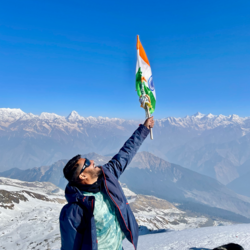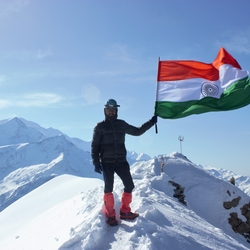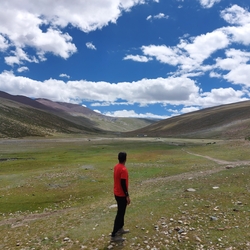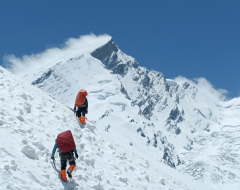Trekking in India- an Experience Like No Other.
From the ice-clad passes of the Himalayas to the rain-soaked jungles of the Western Ghats, India is a geographical and cultural treasure for trekkers and explorers who want to come back different.
Trekking isn’t a hobby. It’s a voluntary breakdown. Of comfort. Of assumptions. Of self-image. But when the snow crunches under your boots, your lungs scream, and your feet ascend, you’ll understand why we keep returning.
The trail doesn’t give you enlightenment. It gives you blisters, altitude headaches, and moments you’ll remember when everything else goes quiet. Nature doesn’t connect with you. It confronts you. With altitude. With isolation. Sometimes with noise, sometimes with silence. It will make you learn and unlearn. It pushes your limits and redefines your capabilities. And, that’s how you grow.
To be thrown out of your comfort zone and into the wilderness, to experience the adrenaline of pushing your limits and reaching summits you once only saw from afar, requires self-challenge. You must challenge your inhibitions, confront your fears, and make your limits to emerge victorious, standing on top of the world, saluted by the cold wind, seeing the world beneath you, quite literally like the king of the world. But that feeling must be earned. Simply buying a package and having someone shepherd you along the trail, telling you what to enjoy, cannot deliver that profound sense of accomplishment. You have to do Bikat things for that.
What does Bikat even mean? Bikat means difficult, and we believe magic happens when difficult things are conquered. Bikat’s name embodies its philosophy.
Hey, what is the story behind it? You’ll find it here.
The Bikat Baby

Image from one of our bases
Tough is respectful. Being tough in the wild means respecting it. That means: no plastic, no shortcuts, no ignorance. You’re not just passing through—you’re part of the ecosystem now.
We offer treks across a spectrum of difficulty levels, each tailored to different fitness levels and learning curves. We have our own Bikat Rating Scale to rate treks as per the level of difficulty.
-
Level 1. Easy Treks: Got guts? Start here.
These are beginner-friendly, short-duration treks with minimal altitude gain. Here, the goal is to give you the taste of blood. Open the crazy world of mountains for you. Easy doesn’t mean effortless. It means ‘Let’s see if this life is for you’. Our easy treks would be:
- Beas Kund Trek
- Brahmtal Trek
- Bhrigu Lake Trek
- Phulara Ridge Trek
- Kuari Pass Trek
- Kedarkantha
- Har Ki Dun Trek
- Ali Bedni Bugyal
Mountain lake view

Trek is easy but the view is hard.
-
Level 2. Moderate Treks: Not your first time? Good.
This is a step up. There will be more exertion and mixed terrain. Perfect for those who’ve done one or two treks before. You can try:
- Rupin Pass Trek
- Sar Pass Trek
- Satopanth Lake
- Tarsar Marsar Trek
- Warwan Valley Trek
- Goechala Trek
- Hamta Pass Trek
- Pin Bhabha Pass Trek
A snap from one of our moderate treks.

Picture perfect
-
Level 3. Difficult Treks: Now, do one that your friends won’t.
For those who are trekking-fit and ready to test their mettle, we have treks that have challenging routes, altitude > 4,000m, and take longer to complete. These are treks you finish sore, salty, and satisfied. You can explore:
- Auden’s Col Expedition
- Dzo Jongo Peak Trek
- Panpatia Col Trek
- Friendship Peak
- Parang La Expedition
- Pin Parvati Pass Expedition
- Yunam Peak Trek
- Rumtse to Tso Moriri Lake Trek
- Mentok Kangri Expedition
Snap from one of our difficult treks

-
Level 4. Technical/Expeditions: No words. Just stories.
Glacier crossings, ropework, ice axes, and treks straight out of Netflix documentaries. These treks require prior experience and fitness. Think:
- Kang Yatse I & Kany Yatse Peak II Expedition (6400 m, 6250 m)
- Mt. Black Peak (6,387 m)
- Mt. CB 13 and CB 14 Expedition (6,238 m, 6,078 m)
- Mt. Deo Tibba Peak (6,001 m)
- Mt. Kun Peak (7,077 m)
- Mt. Nun Peak (7135 m)
- Mt. Nanda Ghunti (6,309 m)
Trekkers on their way.

Going for Summit
Himalayas in Full Glory: A Year-Round Trekking Calendar by Bikat Adventures
Bikat’s trekking calendar aligns perfectly with the natural rhythms and seasonal transformations. Every trek offers an unparalleled experience, showcasing the region's diverse beauty at its absolute peak. Bikat's trek calendar is not just a schedule; it's an invitation to witness nature's grand spectacle, timed perfectly to offer you the most rewarding and unforgettable Himalayan adventure.
Discover the mountains in every season: witness early snowscapes, vibrant spring flowers, lush monsoon greenery with cascading waterfalls, and clear autumn views showcasing colorful foliage ideal for trekking and photography.
Bikat offers treks tailored to each season, ensuring an optimal experience during the most breathtaking time of year, whether you aspire to conquer snowy passes, explore vibrant flower-filled valleys, immerse yourself in lush monsoon scenery, or admire crisp autumn panoramas.
-
Winter treks
The crunch of fresh snow under your boot; the crispness of clean air felt from nose to lungs; the dead cold silence of a snow-covered landscape broken only by the whisper of the fast-blowing winds – these are the sensory hallmarks of a winter trek.
Choosing the right winter trek requires careful consideration of factors such as difficulty level, terrain, altitude, and weather conditions, ensuring a safe and unforgettable journey into this magical winter wonderland. Our winter treks include:
- Annapurna Base Camp Trek
- Dodital Darwa Pass Trek
- Pangarchulla Peak Trek
- Sumda Chey Winter Trek
- Spiti Winter Homestay Trail
-
Summer
The snow’s finally stepped aside. The high passes have opened their gates—but only for those who’ve earned their legs. Recommendations to make the most of your summers:
- Gaumukh Tapovan Trek
- Miyar Valley Trek
- Vasuki Tal Trek
- Kang Yatse II Peak
- Manali Khardung La Cycle Expedition
- Kedartal Trek
-
Monsoon
Monsoon treks test your mental game. Think river crossings, ankle-deep mud, and dense bushes. But also think of raw beauty, no crowds, and stories no tourist will ever collect. Monsoon treks demand careful navigation, each step a test of balance and nerve.
- Saach Pass Cycling Expedition
- Tosamaidan Greater Lakes Trek
- Kalihani Pass Trek
- Leh TsoMoriri Cycling Expedition
- Kang Yatse Peak I
- Kang Yatse Peak II
-
Autumn
This season offers the absolute best conditions to see fall colors and clear skies. What that means is there is a greater chance of seeing far-off great Himalayan peaks. Here are our top recommendations for treks to make the most of this prime time.
No cushy campgrounds. No spoon-fed itineraries. If you’re looking to grow through discomfort, and you like the sound of a mountain calling you out on your excuses, then this is the sign you’ve been waiting for.
The Indian Himalayas stretch across five Indian states, and each one is its universe, with unique cultures, terrains, challenges, and secrets. Whether you're into alpine lakes, ancient trade routes, or heart-pounding passes, there’s a region waiting to break you in (and build you up).
Resting point with a view.

Trekkers Resting while on their way to summit.
So, what do we offer? Let's get into the meat of it: the treks, the seasons, and every wild corner of India we take you to.
The Bikat Offerings
We don’t sell treks. We’re selling a version of you that you’ll respect more.
We're building a 360° adventure platform to introduce global outdoor formats to India and showcase India's remote trails to adventure heads. Our curated experiences push your limits and teach you how to thrive in the wild. Our offerings are built to challenge, educate, and empower. Whether you’re a first-timer with cold feet or a seasoned trekker hungry for altitude, there’s something in the Bikat ecosystem for all.
OUR PROMISE TO THE TREKKER
- We will not curate your comfort.
- We will not sugarcoat the pain.
- We will prepare you for what matters.
- You will leave with something real. Not just photos.
Learning in the wild - Trekking in India "The Bikat Way"
At Bikat, a trek is never just a trek. It’s a learning ground, where your map-reading skills matter more than your Instagram captions, and your ability to pitch a tent beats your ability to post a story. We believe the outdoors are not just scenic—they’re instructive. Every trail we design is a field lab to help you grow: in skills, confidence, and grit.
At Bikat, we don't treat you like a customer but as a co-adventurer. This means embracing a hands-on experience where individuals are expected to actively engage in the trek by pitching their tents, understanding the planned route, taking responsibility for their waste, openly communicating if they feel unwell, and proactively asking questions to facilitate learning through active participation and decision-making.
Whether you sign up for a short trek or an expedition, we make sure you walk away knowing something new:
- How to layer for cold, wind, and wet conditions
- How to use trekking poles effectively
- How to ascend and descend steep sections safely
- How to identify early signs of AMS
- How to pack a backpack for load balance
- How to follow trail markings and natural navigation cues
If you’re on a mountaineering expedition or one of our courses, expect to go deeper.
- Knot-tying, belaying, rappelling
- Crampon and ice axe handling
- Anchor building and rope team movement
- Avalanche awareness and glacier travel basics
- Wilderness First Aid simulations
Trekking Guide

Guidance in the mountains
Wait, how do you choose a trek for yourself?
Don’t pick a trek based on photos. Pick one based on what version of yourself you want to meet.
If you're just starting, go low, go short, go humble. Treks like Kedarkantha, Dayara Bugyal, or Deoriatal Chandrashila Trek give you the taste of blood. If the itch sticks, level up.
If you’ve trekked before, Hampta, Brahmatal, or Sandakphu Trek will punish your calves and reward your mindset.
If you’ve got the lungs and legs, hit Rupin, Pin Bhaba, or Goechala—routes that chew up egos and spit out grit.
If you’re looking at ropes, crevasses, and crampons, then welcome to the club. CB13, Kang Yatse, Nun—they won’t just test your gear. They’ll test your judgment.
Match your trek not to your calendar, but to your capability and courage. Need help? Ask. We don’t oversell. We gatekeep—for your own damn good.
What about safety
Mountains don’t care how pumped you are. They care how prepared you are.
The Himalayas are stunning, but they don’t play nice. Rapid weather changes, high altitude, tricky terrain—they demand respect. At Bikat, safety isn’t a checkbox—it’s the baseline of how we operate. Every trek we run is designed around one non-negotiable: you come back in one piece, stronger than you left. All our trek leaders are well-equipped and skilled enough to handle any crisis.
-
Our Safety Drill
Most companies plan for things to go right. We plan for what can go wrong—and how to respond when it does.
- Pre-Trek Risk Assessments for every batch
- Route recce and seasonal terrain checks
- Batch size limits to avoid chaos and overexposure
- Health check-ups
Read to know “What Makes a Trek 'Safe’?
-
Altitude is no joke.
Altitude Mountain Sickness (AMS), HAPE, and HACE are not buzzwords. They’re real, and we train trekkers to recognize and report symptoms early.
What we do:
- Acclimatization breaks are included in the itinerary
- O2 saturation is one of the data points in the evaluation of the trekker’s condition
- Rapid descent plans for anyone showing serious symptoms
- Batch evacuation plans at every major campsite
Read:
Being Medically Prepared for Outdoors
How do you prepare for a trek?
Want the mountain to treat you well? Show up ready. That includes more than throwing stuff into a backpack the night before your trek. At Bikat, we believe preparation is part of the adventure, and it starts long before you lace up your boots.
1. Have the Right Mindset
- You’re not going on a vacation. You’re going into the wild.
- There will be discomfort. That’s the point.
- The weather won’t care about your schedule.
- The only thing you control? Your readiness.
Equipment to Use on Treks and Expeditions
2. Fitness Matters: Be trail fit.
Trekking isn’t body-building. It’s sustained endurance + uphill resilience.
Basic Fitness Benchmark:
- Climb 6 floors without gasping
- Walk 10 km in under 90 minutes
- Hold a 60-second wall-sit and a 1-minute plank
- Recover overnight after a long hike
Training Recommendations:
- 4 weeks before trek: Walk + stair climbs (5x/week)
- Add strength (squats, lunges, planks)
- Endurance > Speed. Elevation gain > distance
- Optional: Backpack practice walks with a 6-8 kg load
How You Can Prepare Yourself For A Hiking Trip
3. Gear up like a pro, not a tourist
If your gear fails, you fail. Period. We provide tents, sleeping bags, and common gear—but here’s what you need to bring:
The Essentials:
- Backpack (50- 60L) with rain cover
- Layered clothing system (base + mid + outer)
- Trekking shoes (ankle support, broken in)
- Headlamp, not a phone flashlight
- A steel bottle. Plastic is for tourists. You’re not a tourist.
- Trekking poles are optional but highly recommended
Recommended Trek Gear Checklist
4. Medical and Paper Work
- Get a health check-up if you're over 40 or have any conditions
- Fill your medical declaration form honestly (we don’t judge—we prepare)
- Carry basic personal meds + sunscreen + lip balm + ORS
- Bring 2 government ID copies + passport-sized photos
5. What we Provide vs What you Carry
We provide
- Tents, sleeping bags, and mats
- Meals (nutritious, hot, hygienic)
- First aid + oxygen + trek leader + local guides
- Technical gear (where applicable)
You Bring:
- Personal gear, clothes, and mental grit
- Basic hygiene kit
- Mug + spoon + lunchbox (Zero-waste protocol)
When in doubt, talk to us. We don’t expect you to figure it all out alone. Hit us up before your trek and we’ll review your gear, your fitness, and your plan—no judgment, just prep.
Community and Stories - The Wall of Fame
Behind every summit photo, there’s a storm someone walked through—inside and out. Some batches become families. Some fights become legends. Every trek has a moment that could only happen in that weather, with that group, on that day. We’ve seen it a thousand times. City kids. Nine-to-fivers. Introverts. Gym bros. All were stripped down by the mountain and rebuilt as something rawer, stronger, and real.
At Bikat, we don’t collect customers. We build a community of self-improving humans who’ve faced altitude, adversity, and their excuses—and come out differently.
First snow. First summit. The first time someone said “I can’t”—and then did it anyway. Real stories from real people who went from cities to summits, self-doubt to self-belief. These are the stories that make the trek matter.
Frequently Asked Questions
Is it safe to trek in the Himalayas?
Yes—if you prepare, follow instructions, and choose a responsible operator.
We take altitude, terrain, and weather seriously. Our trek leaders are WFR-certified, carry medical kits and oxygen, and follow strict evacuation protocols.
I’ve never trekked before. Can I still join?
Absolutely. Many of our participants are first-timers. Start with an easy or moderate trek. Just don’t treat it like a picnic. You’ll still need to train and gear up.
What happens if I can’t complete the trek?
If you fall sick or can't continue, our team will assess your condition and initiate a safe descent with support. Refunds? No. But dignity? Intact. And next time, you'll be better.
How cold does it get?
Winter treks: -5°C to -15°C
Summer high passes: 0°C to -10°C at night
Expeditions: Colder, windier, unpredictable
Dress in layers. Always carry a down jacket, thermals, and good trekking shoes.
What if it rains or snows?
It will. That’s the Himalayas. We will continue if the route remains safe. Otherwise, we wait it out or adapt the plan. Refunds are not issued due to weather disruptions—we run in nature’s house.
Can I rent gear from Bikat?
Yes. We offer gear rentals for most treks, including tents, jackets, backpacks, headband torches, poles, ponchos, cycles, hand gloves, caps, and trekking shoes. Booking is required.
Do I need insurance?”
For high-altitude expeditions: Highly recommended
For treks: Optional but useful (especially if your luggage is flying domestically)
We don’t sell insurance but can guide you on what to get.
Will there be a network or charging points?
Mostly no. And that’s the point.
Expect no mobile signal above 2,500–3,000m
No charging points at campsites
Carry a power bank, but more importantly, disconnect.
Can I come solo?
Yes. Yes. And you should. Mountains don’t care about your +1. By Day 2, your batchmates will know your snores and your fears.
What’s your refund & cancellation policy?
It’s strict and transparent. Refunds depend on the notice period and trek type. Expeditions, discounted bookings, and last-minute dropouts follow different rules.
Read:






